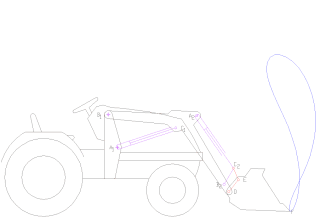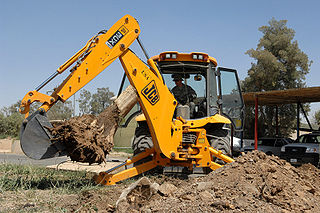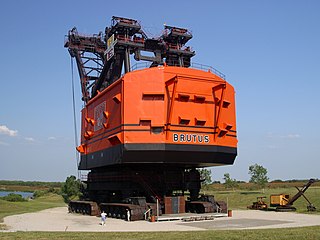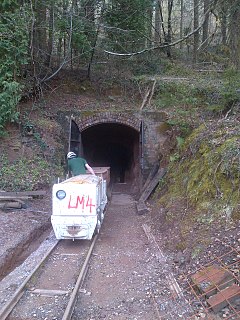

A Rocker Shovel Loader, sometimes simply referred to as a Rocker Shovel or Mucker is a type of mechanical loader used in underground mining. [1]
A Rocker Shovel is usually powered by compressed air, or in some cases electricity. It is commonly mounted on steel wheels designed to run on narrow gauge rails, with some later models using metal or rubber-tyred road wheels. The operator, standing on a raised platform to one side of the machine, operates the controls, one lever to drive the machine along the tracks, and another to raise and lower the bucket. Once the bucket has been filled by driving the loader forwards into the pile of material, the rocker mechanism throws the contents over the top of the machine and into a wagon behind. Once full, the loaded wagon can be taken away and replaced with an empty one to allow loading to continue.
On 28 May 1937, Edwin Burton Royle applied for a patent as inventor of the "loading machine" and US Patent No. 2,134,582 was issued on October 25, 1938 and assigned to the Eastern Iron Metals Company (later to be known as EIMCO). [2]
In 2000, the American Society of Mechanical Engineers added the EIMCO 12B Rocker Shovel Loader of 1938 to its List of Historic Mechanical Engineering Landmarks as reference number 212 out of a total number of 259 objects (as of 2015). [1]

The American Society of Mechanical Engineers (ASME) is an American professional association that, in its own words, "promotes the art, science, and practice of multidisciplinary engineering and allied sciences around the globe" via "continuing education, training and professional development, codes and standards, research, conferences and publications, government relations, and other forms of outreach." ASME is thus an engineering society, a standards organization, a research and development organization, an advocacy organization, a provider of training and education, and a nonprofit organization. Founded as an engineering society focused on mechanical engineering in North America, ASME is today multidisciplinary and global.
In June 2012, an EIMCO 12B Rocker Shovel was featured in an episode of the American reality television series Auction Hunters , filmed in Littleton, Colorado. It was sold to a gold miner for $3,600.

Reality television is a genre of television programming that documents supposedly unscripted real-life situations, and often features an otherwise unknown cast of individuals who are typically not professional actors. Reality television exploded as a phenomenon in the late 1990s and early 2000s with the global success of the series Survivor, Idols, and Big Brother. These shows and a number of others became global franchises, spawning local versions in dozens of countries. The genre has various standard tropes, including "confessionals", or interview segments, used by cast members to express their thoughts, which often double as the shows' narration. In competition-based reality shows, there are other common elements, such as one participant being eliminated per episode, a panel of judges, and the concept of immunity from elimination.

Auction Hunters is an American reality television series that premiered on November 9, 2010, on Spike.
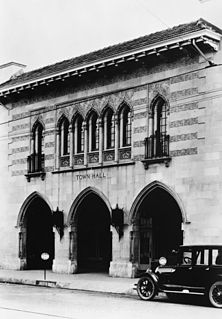
Littleton is the Home Rule Municipality in Arapahoe, Douglas, and Jefferson counties that is the county seat of Arapahoe County, Colorado, United States. The city is a part of the Denver-Aurora-Lakewood, CO Metropolitan Statistical Area. The city population was 41,737 at the 2010 United States Census, ranking as the 20th most populous municipality in the State of Colorado.




